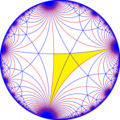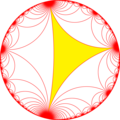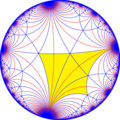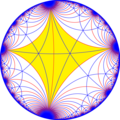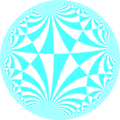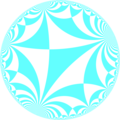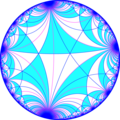Top Qs
Timeline
Chat
Perspective
Truncated triapeirogonal tiling
Uniform tiling of the hyperbolic plane From Wikipedia, the free encyclopedia
Remove ads
In geometry, the truncated triapeirogonal tiling is a uniform tiling of the hyperbolic plane with a Schläfli symbol of tr{∞,3}.
| Truncated triapeirogonal tiling | |
|---|---|
 Poincaré disk model of the hyperbolic plane | |
| Type | Hyperbolic uniform tiling |
| Vertex configuration | 4.6.∞ |
| Schläfli symbol | tr{∞,3} or |
| Wythoff symbol | 2 ∞ 3 | |
| Coxeter diagram | |
| Symmetry group | [∞,3], (*∞32) |
| Dual | Order 3-infinite kisrhombille |
| Properties | Vertex-transitive |
Remove ads
Symmetry
Summarize
Perspective

The dual of this tiling represents the fundamental domains of [∞,3], *∞32 symmetry. There are 3 small index subgroup constructed from [∞,3] by mirror removal and alternation. In these images fundamental domains are alternately colored black and white, and mirrors exist on the boundaries between colors.
A special index 4 reflective subgroup, is [(∞,∞,3)], (*∞∞3), and its direct subgroup [(∞,∞,3)]+, (∞∞3), and semidirect subgroup [(∞,∞,3+)], (3*∞).[1] Given [∞,3] with generating mirrors {0,1,2}, then its index 4 subgroup has generators {0,121,212}.
An index 6 subgroup constructed as [∞,3*], becomes [(∞,∞,∞)], (*∞∞∞).
Remove ads
Related polyhedra and tiling
Summarize
Perspective
This tiling can be considered a member of a sequence of uniform patterns with vertex figure (4.6.2p) and Coxeter-Dynkin diagram ![]()
![]()
![]()
![]()
![]() . For p < 6, the members of the sequence are omnitruncated polyhedra (zonohedrons), shown below as spherical tilings. For p > 6, they are tilings of the hyperbolic plane, starting with the truncated triheptagonal tiling.
. For p < 6, the members of the sequence are omnitruncated polyhedra (zonohedrons), shown below as spherical tilings. For p > 6, they are tilings of the hyperbolic plane, starting with the truncated triheptagonal tiling.
Remove ads
See also
Wikimedia Commons has media related to Uniform tiling 4-6-i.
References
External links
Wikiwand - on
Seamless Wikipedia browsing. On steroids.
Remove ads





